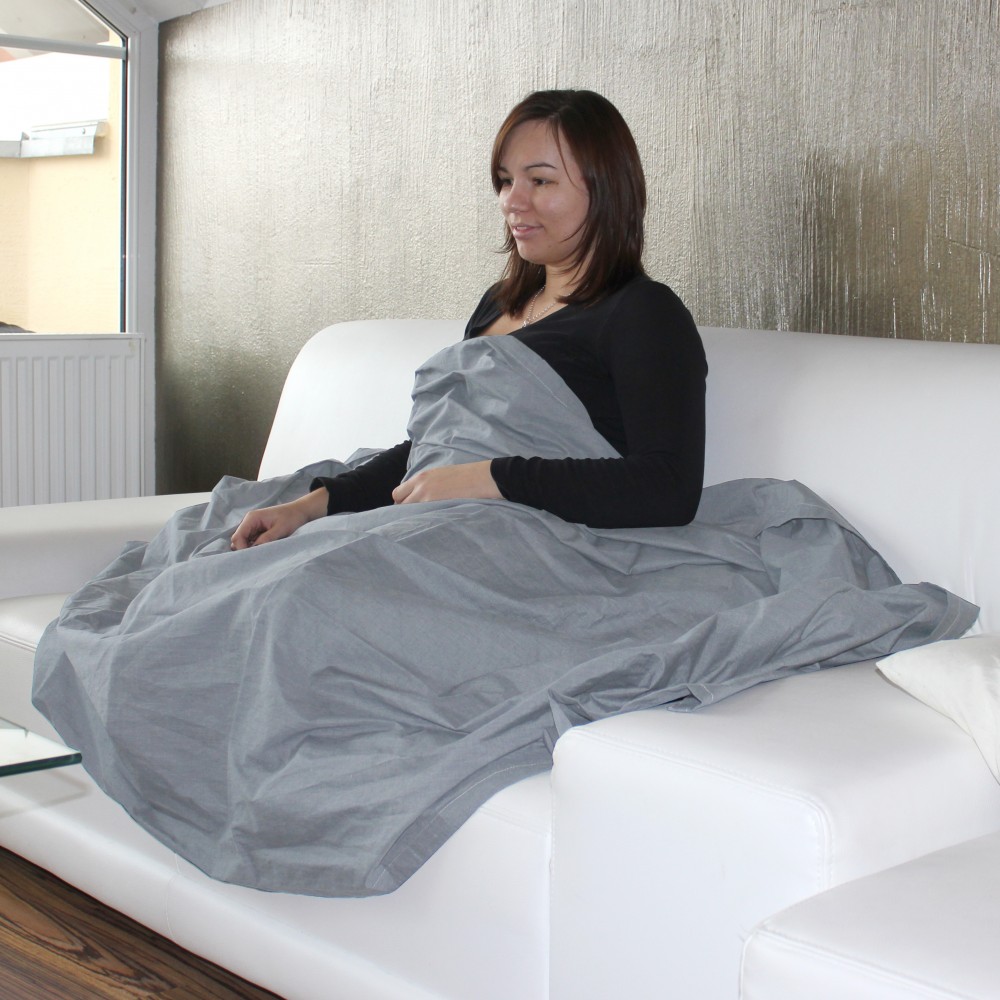With the UK gearing up for 5G and WiFi now prevalent pretty much everywhere you go, should we be looking at the health impact of electromagnetic frequencies?
By Angela Kennedy
Can’t imagine life without your smart phone? You’re certainly not alone. It’s estimated five billion people from a global population of seven billion own a mobile phone device,(1) half of which are smart phones. These pocket-sized devices have revolutionised the world. Now, friends and family are just a smart phone click away. Films, music, news, podcasts and shopping are all available at the swipe of a screen. Everything has become closer, faster and easier thanks to smart technology. You might even find or have found your soul mate on a dating app!
While the benefits of smart tech are obvious, the implications for long-term health are not so clear. Mounting scientific evidence suggests electromagnetic fields (EMFs) emitted by smart devices may damage health. In 2011, the World Health Organisation (WHO) classified radiofrequency EMFs as a “2B carcinogen”. This means EMFs from smart devices are possibly carcinogenic to humans based on an increased risk of glioma (malignant brain cancer) associated with wireless phone use (2).
Since then, other scientists have called for a higher-risk classification of 2A to be applied (3), which would put EMFs in same category as anabolic steroids and lead compounds.
In 2015, a group of scientists from across the globe sent an appeal to WHO calling for greater health protection on EMF exposure and to educate the public on the possible health risks. To date, 247 scientists from 42 nations have signed this appeal.
Most mobile phone providers in the UK are not forthcoming with information on EMFs, simply saying there is no definitively proven risk to human health. This may be true but it isn’t the whole picture. In the UK, the official advice from the Department Of Health is: “Scientific studies suggest electric and magnetic fields are unlikely to be harmful at the levels normally found in homes, although there is some uncertainty regarding certain health effects.” (4). Not very reassuring. Plus, buried in the small print of most mobile phone instruction manuals is advice along these lines: “To reduce exposure to RF energy, use a hands-free option, such as the built-in speakerphone, the supplied headphones, or other similar accessories (iPhones) and keep the mobile device and its antenna at least 2.5cm (1 inch) from your body when transmitting.”
What are EMFs?
So what’s going on? Electromagnetic radiation is emitted by any device with an electrical current. It’s also in UV rays and X-rays. Electric fields are measured in volts per metre (V/m), while magnetic fields are measured in microteslas (µT). Smart technology devices, including phones, TVs, metres, laptops, radios, routers, speakers and alarm clocks, all emit EMFs. Any electronic device communicating with other electronic devices by wireless technology, such as WiFi, 4G, 5G or Bluetooth, emits radiofrequency EMFs.
Household appliances, i.e. washing machines, wiring, vacuum cleaners, electric razors and hairdryers, emit low-frequency EMFs. Outside the home, power lines, substations and phone masts emit low-frequency EMFs, too. Radiofrequency EMFs are more intense and are emitted by devices likely to be closer to your body, and for longer periods of time, such as from mobile phones and laptops, as opposed to washing machines and vacuum cleaners. So the EMFs from smart devices could pose a higher health risk.
Science recognises UV rays and X-rays can be harmful to health because they give off ionising radiation, which can damage the cells in your body. However, radiofrequency and low-frequency EMFs are non-ionising radiation, meaning they can’t damage your DNA. So if that’s the case, what’s the problem?
‘Radio frequency is not strong enough to break DNA strands, which leads to the conclusion that it cannot cause cancer. But, there’s evidence EMFs at the levels given off by mobile phones could cause free radicals to form (5). These are toxic by-products of your metabolism, which damage cells in a process called oxidative stress. And this process may play a role in the development of cancer,'(6) says Graham Lamburn of Powerwatch, a non-profit UK organisation (powerwatch.org.uk) that has been looking into links between EMFs and health risks for three decades.
What’s a safe level?
At present, there’s no legally binding legislation enforcing EMF limits in the UK. The UK Government follows recommendations by the International Commission on Non-Ionizing Radiation Protection, which suggests limits of 61 V/m for radiofrequency EMFs (i.e. from phones and laptops) and 9000 V/m plus 360 µT for low-frequency EMF exposure from appliances or devices. But Powerwatch believes these guidelines are outdated and possibly unsafe because studies have shown biological effects at far lower levels (7). ‘Sensitive people may suffer from headaches, fatigue or sleep disturbance at levels of only half a volt per metre,’ says Graham. ‘If you hold a phone to your head, the part of your brain closest to the device is typically exposed to 25-30 V/m for the duration of the call, whereas if you’re in your living room and two people are using the WiFi router in that same room, you are exposed to about 2 V/m. So, by keeping your distance from EMF-emitting devices, you can dramatically reduce your exposure.’
But with new 5G being rolled out this year, everyone’s exposure to EMFs looks set to increase. ‘The 5G network is being developed for increased power usage on smart devices, such as streaming high-definition films. It’s not the technology that’s harmful but the quantity of data used, requiring more power to make it work. With a greater number of power masts needed to facilitate 5G, it will be difficult to avoid EMF exposure outside your home,’ says Graham.
Nick Pineault, author of The Non-Tinfoil Guide to EMFs (theemfguy.com), believes there’s industry pressure on legislators to keep EMF exposure limits high. ‘Business has a vested interest in EMF limits staying at the current permissive levels of countries like the UK, Canada, USA and Australia because the industry is so lucrative. Also, EMF risk is not a popular message because people don’t want it to be true. Everyone loves their smart devices,’ he says.
Clear answers on the risks of EMFs may not emerge for decades because much more research is needed and because health effects may not be apparent for 30 years or more. But so far, science points to potential risks.
Science finds EMFs can be harmful to the body
Four cases of young women with no family history of breast cancer, who developed tumours in their breast, have been reported by the Breastlink Orange Medical Center in California (8). All four had been putting their mobile phone inside their bra for hours while exercising. Tumours developed in the area of their breast where the phone was placed. Researchers therefore raised the concern of a possible association between EMFs from phones and breast cancer.
The link between decreased sperm motility and mobile phones is also well documented – just one study in 2014 found that mobile phone radiation was associated with a reduction in sperm motility and viability (9). ‘This could lead to decreased fertility in men, especially those who carry their phone in their trouser pocket,’ says Nick.
Dementia may also be a risk associated with low frequency EMFs, such as the magnetic fields emitted by power lines. A scientific committee on emerging health risks found that those living within 50m of a 220-380 kV power line had twice the risk of developing Alzheimer’s or other types of dementia after 15 years compared with the general population (10).
And the possible effects on children are particularly concerning. These are the first generations to have grown up with exposure to smart tech EMFs from birth. ‘Children’s brains are especially at risk because their head absorbs twice the EMFs compared to adults (11). Yet it’s common for children to spend hours everyday on their phones. A 2014 study reported 75 per cent of the four-year-old children studied owned their own smart phone (12). There’s even a possible link between EMFs and autism in children,’ (13) says Nick.
While all this research is troubling, more studies are needed to prove harm. Nick advises caution rather than panic. ‘To put things into perspective, if you’re on the phone for a couple of minutes, it’s not a big risk. In the future, EMFs may be the next big health crisis, such as tobacco smoking, but while you’re waiting to find out, why not be cautious by eliminating as many risks as possible?’
It’s too difficult to rank devices from worst to ‘least worst’ when it comes to EMFs as proximity to your body and high power usage create the strongest exposures. While phones can be one of the greatest sources of EMFs for most people, sending texts will generate a lot less radiation that streaming a three-hour high-def film, as more power is needed for the latter. Also, when it comes to routers, the more people accessing them, the worse the emissions. So if you’re at home and a few people are using WiFi, it’s not as bad as sitting in a café with 30 other people all accessing the same network.
Try following Nick’s guidelines for reducing EMF exposure while not completely giving up your smart devices:
- Have a building biology survey: Instead of checking for structural problems in your home, these experts check for EMFs. They can measure whether you have high EMF radiation, pinpoint where it’s coming from and advise on the solution (buildingbiology.co.uk)
- Switch to airplane mode: Doing this stops radiofrequency EMF transmissions to your phone or other devices. You can still take photos, listen to pre-downloaded content and use the alarm clock in this mode. Why not create an offline Spotify playlist or pre-download episodes from your favourite podcasts? Also, turn off your WiFi router when not in use, especially at night, by unplugging it from the socket. Try using a timer plug with it so you don’t have to remember!
- Create distance: Devices closest to your body are linked to the biggest EMF exposure, so create distance between you and them. One foot distance between you and your phone while talking on it is sufficient. Use speakerphone or headphones. Just avoid Bluetooth earphones because, being wireless, they too emit EMFs!
- Clean up your bedroom: EMFs can cause sleep disruption (14), and several studies show they may affect melatonin production (15), which is the hormone that regulates sleep. Remove smart devices and anything with wireless capability from your bedroom at night, including Bluetooth alarm clocks. Household wiring can also emit EMFs but you can stop this by turning off the circuit breaker to your room. Try switching everything off at night for a week and see whether your sleep improves.
- Connect with wires: Ethernet cables are how you connected to the Internet at home before WiFi. You can use them to connect your laptop to your router to dramatically reduce EMF exposure.
More than 44% of the world’s population has EMF exposure guideline levels that are at least 10 times lower than UK guidelines (15).
Crazy but true! Tin foil really does protect against EMFs! It’s made of aluminium, which blocks radiofrequency and low-frequency EMFs. You could cover small devices, such as routers, with for protection, although you might risk being accused of belonging to the ‘tin foil hat’ brigade!
7 ways to protect yourself at home and on the go

Whole-house EMF blocker
Protect your home or office against EMFs with a Transformer 28-4G-H Large Home/Building (£775, bioprotectivesystems.com), It creates a protective zone of up to 66m2 by neutralising harmful frequencies. Place it in the centre of your home or office for best effects. A new Transformer 5G will be available by 2021 to protect against 5G frequencies.

Laptop blockers
Defend against heat and radiation from your laptop by placing it on a WaveWall Pad (£74.99, wavewallcases.com). ‘Our shielding technology is based on the well-proven Faraday cage (a protective shield made of a conductive material that distributes electrical charges or radiation around the cage’s exterior, cancelling them out inside the cage). It’s been scientifically tested and shown to reduce Specific Absorption Rate (SAR) by 85 per cent,’ says Harry Gardiner from WaveWall. ‘SAR is a measure of the rate at which energy is absorbed by your body when exposed to a radiofrequency EMFs. The higher the SAR level, the more radiation absorbed into your body.’

Mobile phone protection
For protection from your phone, try a WaveWall Flip for iPhone (£39.99, wavewallcases.com) or Universal (£24.99). ‘Mobile phone use is essentially a massive public health experiment because the effects of lifelong exposure to them are unknown as they haven’t been in use for long enough,’ says Harry of WaveWall. These cases create a fabric shield of metal fibres to deflect radiation while still allowing your phone to work normally.

EMF-cancelling headphones
To listen to music on your phone or make a hands-free call, try the EchoTubeZ Radiation-Free Air Tube Headset (£24.99, electrosmogshielding.co.uk) which block up to 98 per cent of EMFs emitted by your device. A remote control module on the headset allows you to play, skip, select, answer and end a phone call.
 Protective pendants and keyrings
Protective pendants and keyrings
Try wearing the Green8 Body Harmoniser Pendant (£98, healthy-house.co.uk), which creates a ‘positive’ frequency to neutralise the EMFs from mobile phones and WiFi. Also, the Bioclip (£35, above) can be attached to your belt or bra strap, It contains a biodot of magnetic material to help counteract EMF.
Shielding Fabric & Bedding
Block EMF emissions from coming through windows with Evolution Shielding Fabric (£79 per metre, electrosmogshielding.co.uk) which is made from ultra-thin, high-tech yarn. You can also use it as a canopy over your bed, or try the Blanket HF+LF Shielding (£82.89), which contains super-fine stainless steel thread to block EMFs.
 EMF Shielding Paint
EMF Shielding Paint
Easy to use, the YSHIELD HSF54 HF+LF Shielding Paint (£41.98 for 1litre, electrosmogshielding.co.uk) can be used indoors or outside to protects against radiofrequency and low-frequency EMFs.
Study References
2) International Agency For Research On Cancer report for WHO
6) Dreher D, Junod AF, Role of oxygen free radicals in cancer development, Eur J Cancer, 1996 Jan.
And
12) Hilda K. Kabali, Exposure and Use of Mobile Media Devices by Young Children, Paediatrics, 2015 Dec
(16) powerwatch.org.uk









